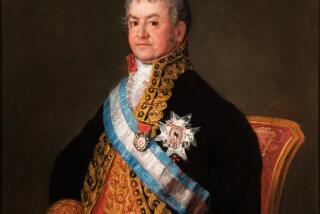A museum-warming gift
Two months after opening its new home in San Francisco’s Civic Center, the Asian Art Museum has beefed up its holdings of Chinese art with a gift of 135 paintings and calligraphic works dating from the 7th century to modern times. Known as the Yeh Family Collection, the artworks were acquired over the last 150 years by several members of a Chinese family and donated by their heir, Max W. Yeh, who lives in Mendocino.
The gift -- including spontaneously brushed paintings by modern masters, historic scrolls and accordion-like albums of calligraphy -- fills a gap in the museum’s collection, said Michael Knight, senior curator of Chinese art. Although the museum already had 6,500 Chinese objects before receiving the Yeh collection, fewer than 400 of them are paintings and calligraphies.
Avery Brundage, the Chicago industrialist and longtime president of the International Olympic Committee who founded the museum and donated its core collection, was an aficionado of Chinese art. But he was “an objects person,” Knight said. “He wasn’t very fond of paintings and calligraphies, so that has been our one weakness in the Chinese area.” Particularly strong in calligraphy, traditionally the premier visual art of China’s intelligentsia, the Yeh donation “adds a dimension of educated, elite Chinese taste” to the museum’s holdings, he said.
Among the most notable items is “Yinfu jing,” a 12-leaf album that is the only known work by Chu Suiliang, an imperial calligrapher who lived from 568 to 658. “Duo Jing Luo,” an 11th century album, presents a poem about a Chinese temple done in the hand of calligrapher Mi Fu. Works by 17th century calligrapher Fu Shan include three hanging scrolls in his spontaneous signature style and a hand scroll of his writings compiled by his students after his death in 1690. There are also modern pieces, such as “Lotus,” a 1964 hanging scroll painted in ink by Zhang Daqian.
The 135 pieces donated to the museum are what remains of a distinguished collection that was largely dispersed amid political upheavals in China, donor Yeh said. One of his ancestors, Yeh Yinghua, who established a painting society in southeastern China, is thought to have founded the collection in the mid 19th century. His son, Yeh Yanlan -- who was an artist, scholar and government functionary -- probably added many works.
But the family’s most active collector was Yeh Gongchuo, the son of Yanlan and the great-uncle of the donor. “He was a major intellectual and public figure,” Yeh said. “He was a minister of communications and railroads. He founded a museum, a library and a university in Shanghai. This collection is really his.”
Gongchuo left part of his collection to Max’s father, Yeh Gongchao, a distant cousin whom Gongchuo had adopted.
Gongchao died in 1982, leaving his artistic inheritance to Max. But by then, the family had suffered huge losses.
“My father was the foreign minister in the Nationalist government during the civil war in China, when the Communists threw out the Nationalists,” Yeh said. “He was responsible for packing and taking the National Palace collection out of the mainland to Taiwan. I think he took part of his uncle’s collection out at the same time, but a lot of it remained in China and was destroyed during the Cultural Revolution.”
Gongchao spent most of the rest of his life in Taiwan but sent his wife and children to the United States in 1944. They landed in California when Max was about 7 and settled in Davis. He became a professor of Western literature and art, teaching at UC Irvine, the University of Iowa and other colleges and is now retired.
Yeh never collected Chinese art, but he became keeper of the family’s artistic flame.
“My father told me that the collection was not to be bartered for money because it was our family’s investment in the aesthetic world, which I certainly believe,” he said. “Paintings are more important than money. The amazing thing is that the artwork has been transported around and people have taken care of it because it was important to them.”
While searching for a permanent home for the collection, Yeh found that some museums with important holdings of Chinese art, such as the Metropolitan Museum of Art in New York and the Cleveland Museum of Art, wanted specific pieces but wouldn’t promise to maintain the entire collection, as he wished. But officials at the Asian Art Museum were delighted to accommodate him.
“They wanted to round out their collection,” he said. “Our interests meshed.”
An exhibition of 70 or 80 works from the Yeh collection will be held in 2006, in conjunction with the publication of a catalog.
More to Read
The biggest entertainment stories
Get our big stories about Hollywood, film, television, music, arts, culture and more right in your inbox as soon as they publish.
You may occasionally receive promotional content from the Los Angeles Times.










